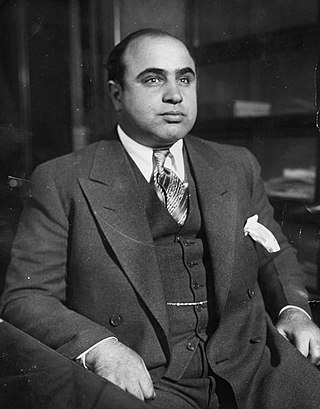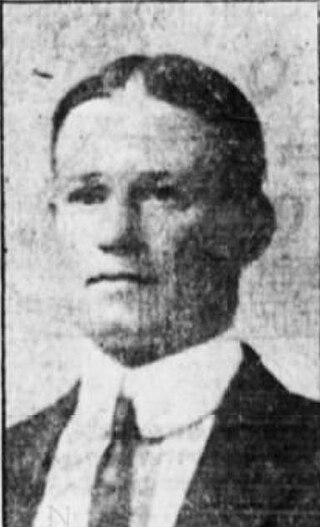
Alphonse Gabriel Capone, sometimes known by the nickname "Scarface", was an American gangster and businessman who attained notoriety during the Prohibition era as the co-founder and boss of the Chicago Outfit from 1925 to 1931. His seven-year reign as a crime boss ended when he went to prison at the age of 33.

John Donato Torrio was an Italian-born American mobster who helped build the Chicago Outfit in the 1920s later inherited by his protégé Al Capone. Torrio proposed a National Crime Syndicate in the 1930s and later became an adviser to Lucky Luciano and his Luciano crime family.

Vincent Drucci, also known as "The Schemer", was an American mobster during Chicago's Prohibition era who was a member of the North Side Gang, Al Capone's best known rivals. A friend of Dean O'Banion, Drucci succeeded him by becoming co-leader. He is the only American organized crime boss to have been killed by a policeman.

Francesco Ioele, known as Frankie Yale or Frankie Uale, was an American gangster based in Brooklyn and the second employer of Al Capone.

Vincenzo Colosimo, known as James "Big Jim" Colosimo or as "Diamond Jim", was an Italian-American Mafia crime boss who emigrated from Calabria, Italy, in 1895 and built a criminal empire in Chicago based on prostitution, gambling and racketeering. He gained power through petty crime and heading a chain of brothels. From 1902 until his death in 1920, he led a gang known after his death as the Chicago Outfit. Colosimo was assassinated on May 11, 1920, and no one was ever charged with his murder. Johnny Torrio, an enforcer whom Colosimo imported in 1909 from New York, seized control of Colosimo's businesses after his death. Al Capone, a close associate of Torrio, has been accused of involvement in Colosimo's murder but was not yet in Chicago at the time.

The Chicago Outfit is an Italian-American organized crime syndicate or crime family based in Chicago, Illinois, which originated in the city's South Side in 1910. It is part of the larger Italian-American Mafia.
Maurice "Mossy" or "Mossie" Enright was an Irish-American gangster and one of the earliest Chicago labor racketeers in the early 20th century.

The Levee District was the red-light district of Chicago from the 1880s until 1912, when police raids shut it down. The district, like many frontier town red-light districts, got its name from its proximity to wharves in the city. The Levee district encompassed four blocks in Chicago's South Loop area, between 18th and 22nd streets. It was home to many brothels, saloons, dance halls, and the famed Everleigh Club. Prostitution boomed in the Levee District, and it was not until the Chicago Vice Commission submitted a report on the city's vice districts that it was shut down.
Chicago, Illinois, has a long history of organized crime and was famously home to the American mafia figure Al Capone. This article contains a list of major events related to organized crime.
The Genna crime family, was a crime family that operated in Prohibition-era Chicago. From 1921 to 1925, the family was headed by the six Genna brothers, known as the Terrible Gennas. The brothers were Sicilians from the town of Marsala and operated from Chicago's Little Italy and maintained control over the Unione Siciliana. They were allies with fellow Italian gang the Chicago Outfit. After a bloody war led to their demise in the 1920s, the gang was eventually absorbed by the Chicago Outfit.
Samuele Cardinelli was an American mobster, extortionist, and leader of Cardinelli Gang of Chicago during the 1920s.
Joseph Esposito was an American politician best known for his involvement in bootlegging, extortion, prostitution and labor racketeering in Chicago, Illinois during the Prohibition era.
Michael "The Pike" Heitler was a Prohibition gangster involved in prostitution for the Chicago Outfit. A Jewish mob boss born in what is today Ukraine, Heitler is buried at Waldheim Cemetery Co. in Forest Park, Illinois.
Shotgun Man is an alleged assassin and spree killer active in Chicago, Illinois in the 1910s, to whom murders by Black Hand extortionists were attributed. Most notably, Shotgun Man killed 15 Italian immigrants from January 1, 1910, to March 26, 1911, at "Death Corner," a notoriously violent Italian immigrant neighborhood at the intersection of Oak Street and Milton Avenue in what was then Chicago's Little Sicily. The area was notorious for violence committed by Italian immigrants and Italian-Americans, both independently and as a result of Italian gangs, the Mafia, and Black Hand feuding and vendettas. In March 1911, the so-called Shotgun Man reportedly murdered four people within 72 hours.
James Cosmano also known as "Sunny Jim" was a leader of the Black Hand street gang in pre-Prohibition Chicago who tried to extort money from the South Side gang.
Michele "Mike the Devil" Genna was an Italian-born mobster in Chicago during the 1920s. He headed the Genna crime family with his brothers. He was killed by police officers after a shootout with North Siders, being one of the only American organized crime leaders to be killed by a policeman.

Robert "Roxie" Vanella was an American crime figure of Italian descent. He was associated with Johnny Torrio, Big Jim Colosimo, Frankie Yale and Al Capone during the Prohibition era. In his later years, Vanella became a businessman and union organizer operating from the Lower East Side neighborhood of New York City, where he became fondly known as the "Mayor of James Street."
This is a list of organized crime in the 1900s, arranged chronologically.
This is a list of organized crime in the 1910s, arranged chronologically.
This is a list of organized crime in the 1920s, arranged chronologically.








